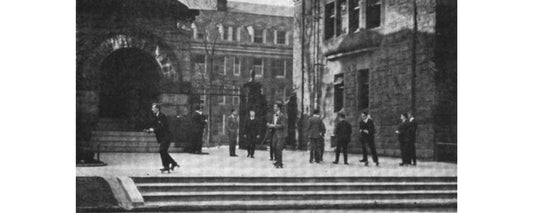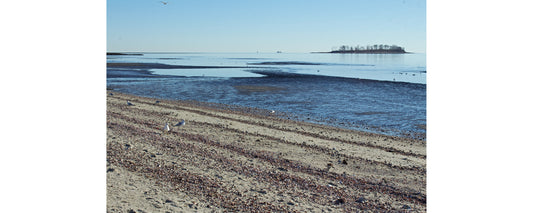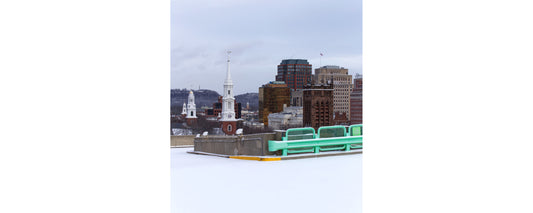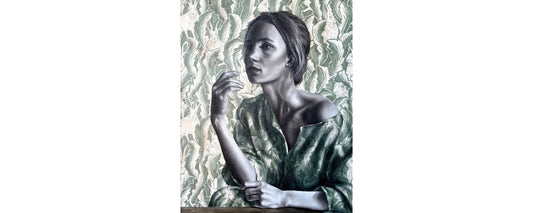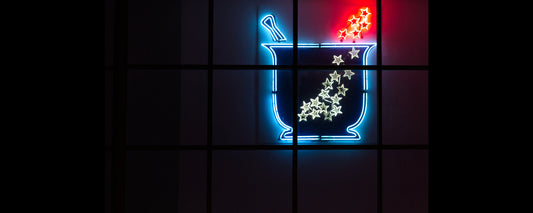There’s something about the moment of a shipwreck—the strange incongruity of smoke and fire on water, of splintered masts and snapped riggings on glassy sea.
The Yale Center for British Art’s new show Spreading Canvas: Eighteenth-Century British Marine Painting makes canny use of these moments to draw viewers in. You might come for the sea fights, but by the end of the exhibit you find yourself immersed in the story of the British people and their inexorable connection to the sea.
The paintings and objects on display are “not just static representations,” according to the show’s curator, Eleanor Hughes. They’re stories in and of themselves. As the show progresses, you become aware of the people behind these hulking ships: the rowdy sailors, the bold (if prone to exaggeration of their boldness) captains, the men of the dockyards and, of course, the painters themselves.
sponsored by
Spreading Canvas begins with a hugely influential father-son painting team, both named Willem Van de Velde, who fled their native Holland for Britain and ended up defining their new country’s maritime painting tradition for an entire century.
In the Van de Veldes’ more idyllic scenes, grays and jade greens and the parchment whites of sails are seen at a distance, in the bright even light of fine weather. The foreground is darker and the far reaches of the canvas are flush with sunbeams, blue skies and wispy clouds. These techniques can be found throughout the exhibit, as generations of English maritime painters would follow in the Van de Veldes’ paint strokes.
The color palette and staging in the duo’s sea-fight and shipwreck paintings are another story entirely. In A Storm, positioned near the beginning of the exhibit, a long sweeping virga and an ominous rock rising out of the dark sea frame a struggling ship as it’s pounded against a craggy cliff. The sailors are little dabs of soft grey paint, clinging to rigging or dropping into the churning sea. Seen at a great distance, and shrunken by the helplessness of their circumstances, they’re featureless—already ghosts. You feel that the tragedy belongs to the ship itself, as opposed to the doomed souls aboard it.
The motif of the tragic ship is at its best here in Charles Brooking’s Ship Wrecked on a Rocky Coast. The content is the usual—mayhem at sea, a lonely vessel succumbing to the elements, tremendous light from the heavens, terrible darkness from the ocean—but Brooking has a keener eye for the brutal reality of the situation. The canvas is despairing, dark, with light hitting only the froth of waves around the hull and the splintered tops of the broken masts. The ship is already sinking, leaning away from the viewer at a fatal angle.
The fury of nature, while well-represented in the beginning of the exhibit, soon takes a back seat to the seemingly just as inevitable fury of man. Wars at sea were maritime painters’ bread and butter. A terrible storm is an act of God; the defeat of an enemy armada is an act of the British navy, which is more stirring in some quarters.
The exhibition progresses in rough chronology, from the Van de Veldes’ arrival in England in 1673 to the mid- to late eighteenth century, images of British and French ships vying for control over international ports track the rise of the British Empire alongside the storied East India Trading Company. A representative work in this vein is Dominic Serres’s painting of the British capturing the French colony at Chandernagore, India, a victory that marked the EITC’s transformation into a global power.
Perhaps it’s no coincidence that Serres depicts the sea as a nearly flat surface, looking as dependable as a paved road. How else should the ocean behave for the new masters of the universe?
One of the primary pleasures of walking through Canvas is seeing the appearance of people as the century in question progresses. You can almost watch the British Empire populate itself. In the last two galleries, the soft inhuman shapes of sailors clinging to their ships are gone. Instead, you see men, women and children, all gathered on the docks, waving to ships in the bay, watching bridges being built. A people defined by its relationship to the sea finally appears.
Hughes’s curatorial skills are on full display at the end of the exhibit, which presents two large paintings that together serve as a harrowing and compelling coda to the exhibition.
The first of two, Philippe-Jacques de Loutherbourg’s Glorious Defeat of the Spanish Armada is a massive canvas depicting the famous 1588 battle. It’s shocking to come across after a string of more sober, controlled battles accented by civil puffs of smoke. Loutherbourg’s painting is nearly obscene by comparison—all fiery reds and nauseous greens and writhing bodies.
The final painting of the show is John Scarlett Davis’s depiction of the National Gallery of Naval Art, which was on display in the Royal Hospital for Seaman at Greenwich. On the walls are marine paintings (including one by Loutherbourg), old men on canes passing beneath them. These are veterans of the naval battles, parishioners at the hospital, and they spend their days giving tours of the great exploits that maimed them.
Painted in 1830, Davis’s work commemorates the long tradition of marine painting in Britain, 150 years after the Van de Veldes first arrived in the country. It’s a sobering coda to an often swashbuckling exhibition, which leaves you with a new appreciation for ships, the seas that they sailed and those briny men who fought, lived and often died aboard them.
Photo Key
1. Nicholas Pocock’s The Brunswick and the Vengeur du Peuple at the Battle of the First of June, 1794 (1795)
2. Charles Brooking’s Shipping in the English Channel (circa 1755)
3. Samuel Scott’ Vice Admiral Sir George Anson’s Victory off Cape Finisterre (1749)
4. Willem van de Velde the Younger’s Sea Battle of the Anglo-Dutch Wars (detail, circa 1700)
5. Samuel Scott’s The Thames and the Tower of London Supposedly on the King’s Birthday (1771)
Spreading Canvas: Eighteenth-Century British Marine Painting
at the Yale Center for British Art
1080 Chapel St, New Haven (map)
Tues-Sat 10am-5pm, Sun 12-5pm
(877) 274-8278
www.britishart.yale.edu/exhibitions/…
Written by Sorrel Westbrook. Photos, cropped to fit, provided courtesy of the Yale Center for British Art.




